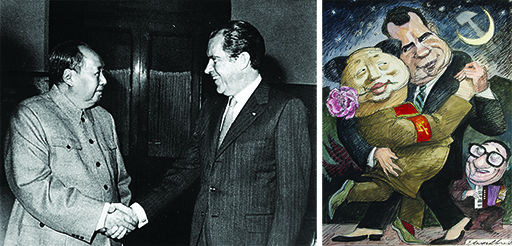1.5 The twentieth century
After the Russian Revolution in 1917, Western powers were concerned to restrain the influence of communism. China became embroiled as an unwilling participant in US strategies to contain this influence. The United States supported the formation of the nationalist political regime that replaced the monarchy in China in 1911, anticipating that this could generate a society that shared the social ideals of Western states and create new markets. However, a significant communist insurgency arose, in part financed by the Soviet Union. US diplomats, influenced by Edgar Snow’s eulogising image of communist leader Mao Zedong in A Red Star over China (1937), saw the communists as a progressive movement seeking to modernise China and helped convince US President Roosevelt to view Mao as a populist leader who could be sympathetic to the United States. They also saw all Chinese forces as posing a threat to Japan, the United States’ rival at that time. Similarly, the Soviet Union had ties to both nationalists and communists in China, seeking to protect its vulnerable Siberian territories and Asian trade routes from Japan.
In 1931 the Japanese attacked Manchuria, an area of China, leading to an all-out invasion in 1937 that weakened the Chinese nationalist government and military. Following the surrender of Japan at the end of the Second World War in 1945, Chinese communists and nationalists resumed the civil war, culminating in communist victory. At first, Maoist China remained close to the Soviet Union and became embroiled in the Cold War between the United States and the Soviet Union. However, over time, differences with the Soviet Union emerged and in 1959 they became competitors in the international system offering two different models of communism. China was viewed by successive US presidents from Dwight Eisenhower to Lyndon Johnson as part of the wider ‘communist threat’; a view reinforced by China’s acquisition of nuclear weapons in 1964. China’s involvement in the Korean War (1950–1953) pitted Chinese troops directly against US forces and their allies, resulting in a stalemate that continued to divide North and South Korea well into the twenty-first century. In the 1950s and 1960s internal developments dominated China, which led to widespread, mass famine and the extensive purges of the Cultural Revolution. However, China was also a key participant in the 1955 Bandung conference, which not only laid the basis for the emergence of the Non-Aligned Movement, but also addressed the issue of China’s relations with Asian and African countries. China also supported a number of anti-colonial struggles in the 1950s and 1960s.
Though now a sovereign state, China’s place in the international system remained contested: China’s seat in the United Nations (UN) system was occupied until 1971 by the nationalists who were in their last foothold of the island of Formosa, now Taiwan. (The existence of Taiwan as a separate country from mainland China remains a source of international tension.) However, in the 1970s, a thaw in China–United States relations allowed the United States to put pressure on the Soviet Union and gave China a counterbalance against a potential Soviet threat. The United States was also heavily involved in the Vietnam War, seeking to prevent a communist movement (supported by the Soviet Union) coming to power, and China saw the conflict as a means to limit increasing Soviet influence in North Vietnam. Seeking geopolitical advantage and rivalry in the region and globally was an intrinsic part of these changes in relations for both China and the United States.
A period of détente between China and the United States was symbolised by President Richard Nixon visiting China in 1972 and engaging in negotiations with Chairman Mao. The Chinese government sought full UN status in 1971 and became a member of the UN Security Council. It is arguable that the eventual withdrawal of US forces from South East Asia was made more palatable to the United States with China acting as a more neutral counterbalance to Soviet communism in the region. Full diplomatic recognition of China by the United States eventually came in 1979 (Foot, 2006).

Nevertheless both the United States and China continued to pursue their own regional interests and strategies. The United States maintained a string of strategic military bases and supported friendly governments in Japan, South Korea, Taiwan, the Philippines and Thailand. Similarly China engaged in regional intervention assuming, like the United States, that its interests demanded regional stability and friendly governments or client states in the immediate vicinity. For its part, China supported the Khmer Rouge in Cambodia in the 1970s and encouraged their border harassment of Vietnam. It engaged in a long conflict with Vietnam after the United States had departed in 1975, continued to support the communist regime in North Korea, and developed close ties to non-communist but resource-rich Burma.
